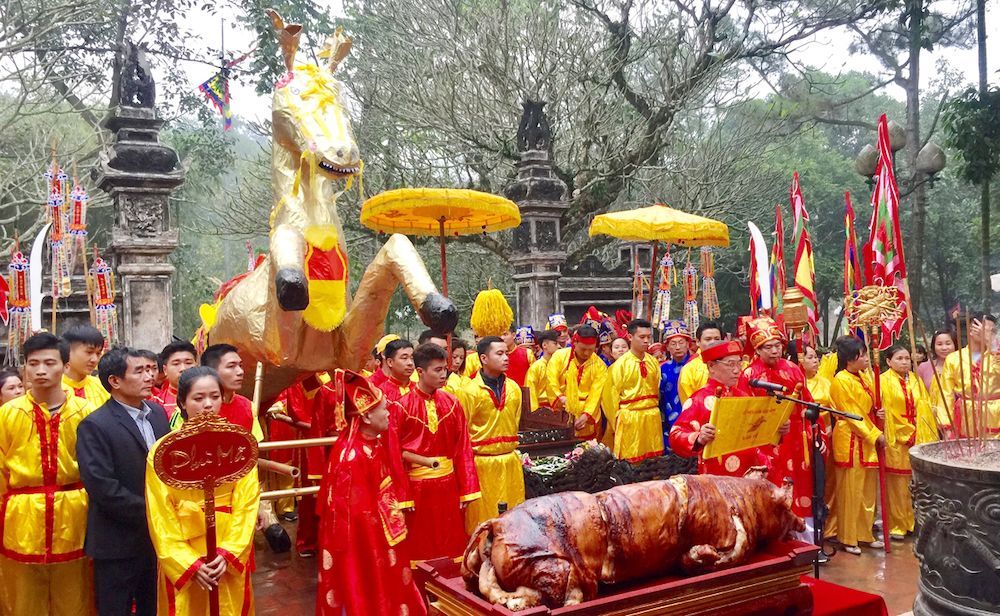Gióng Festival is one of the first festivals in Vietnam to be recognized by UNESCO as an intangible cultural heritage. It is also an occasion for people to revisit history and commemorate the contributions of Thánh Gióng.
Table of Contents
Where are Gióng Festivals held?
Currently, there are two typical Gióng festivals in Hanoi, namely the Gióng festival held at Sóc Temple in Phù Linh commune, Sóc Sơn district, and the Gióng festival held at Phù Đổng Temple, Gia Lâm district. These are also the first festivals in Vietnam to be recognized by UNESCO as intangible cultural heritages.
In addition, in Hanoi, there are many other localities organizing Gióng festivals, such as Thống Nhất commune, Thường Tín district; Phù Lỗ Đoài village, Sóc Sơn district; Đống Đồ, Đông Anh district…
What makes the Gióng festival stand out globally is the cultural values preserved and passed down through generations. Despite being organized in the capital city – close to the center of modern urban development, the Gióng festival still exists independently, sustainably, preserving traditional beauty without commercialization.

When are Gióng Festivals held?
The Gióng Temple festival in Sóc Sơn takes place from the 6th to the 8th day of the first lunar month, while the Gióng Temple festival in Phù Đổng occurs from the 4th to the 7th day of the fourth lunar month.
The legend of Thánh Gióng
The Gióng festivals at the Phù Đổng and Đền Sóc are associated with the legend of a miraculous boy born in Phù Đổng village. The boy, named Gióng, was handsome and robust, but at the age of three, he had yet to speak or laugh, spending his days lying in a bamboo basket hanging from a bamboo frame. However, upon hearing the king’s call for a skilled warrior to defend the country against foreign invaders, Gióng miraculously grew rapidly and volunteered to fight for the nation’s salvation. After defeating the enemy forces, he returned to Mount Sóc and ascended to the sky on a divine horse.
Since then, Gióng has been revered as an immortal saint among the “Four Immortals,” safeguarding the crops, ensuring peace for the nation, and bringing prosperity to all. To commemorate his contributions, people built temples, worshipped him, and organized annual festivals known as the Gióng Festivals at the Phù Đổng and Đền Sóc.
Rituals of Gióng Festivals
Gióng Festival at Phù Đổng Village
Firstly, villagers conduct sacred rituals, followed by a ceremonial procession to fetch water for purification from the ancestral well at the đền Mẫu (đền Hạ), with the hope for favorable weather conditions. Then, the flag procession from đền Mẫu to đền Thượng, followed by a lễ khám đường, lễ duyệt tướng… The main festival day on the 9th of the 4th lunar month sees the most solemn, sacred, and vibrant moments, particularly during the two battles.
The first battle: flag waiving at Đống Đàm and the second battle is at Soi Bia. The battlefield consists of 3 mats, each with a large bowl symbolizing hills, placed on a white paper representing the sky. Surrounding them are the troops of Thánh Gióng, and on the other side are the troops of 28 female enemy generals (symbolizing the yin element). After the ritual, Ông Hiệu (the one believed to carry the flag into battle for Thánh Gióng) advances to each mat, jumping over the “hills” (upturned bowls), and performs flag-raising moves. Cheers intermittently resound amidst the sound of gongs and drums, demonstrating the fierceness of the battle. Ông Hiệu’s flag dance must be precise and skillful to avoid the taboo of the flag getting caught in the stick, as believed by the locals to be a bad omen. At the end of each flag dance is the end of a battle, as Mr. Hiệu steps off the mat, it is tossed up, and the people rush to grab the pieces of the mat they believe will bring luck to their families throughout the year.
Finally, the flag procession marks the victorious news with jubilant celebrations, amidst laughter, songs, and dances by the residents of Ai Lao district, along with traditional activities such as flag-waving and folk games. Even the defeated generals and soldiers are pardoned and invited to join in the festivities. This gesture reflects the tradition of the spirit of tolerance and humanity of the Vietnamese people.
Gióng Festival at Sóc Sơn Temple

The preparation of ceremonial offerings is also meticulously executed, especially the weaving of elephant (according to legend, the army accompanying Thánh Gióng in battle included elephants carrying provisions) and the making of giò hoa tre (bamboo flowers) (symbolizing Thánh Gióng’s bamboo lance after defeating the enemy), which must be carried out weeks before the festival. Since ancient times, the procession has been specifically assigned to each village: First, Vệ Linh village parades the giò hoa tre, followed by Dược Thượng village with elephants, Đan Tảo village with betal leaves, Đức Hậu village with ivory, Yên Sào village with cỏ voi (banana tree trunk), Yên Tàng village with the general, and in recent years, Xuân Dục village added the tradition of parading the “Cầu Húc” (a sphere symbolizing the sun, according to the ancient belief in sun worship among the local residents).
After the ritual bathing of the Thánh Gióng statue and the solemn offering ceremony, the two most bustling activities of the Soc Temple Festival occur. These are the “cướp hoa tre” (bamboo flower snatching) ritual for good luck and the ritual “chém tướng” (beheading of the enemy), symbolically enacted by the flag-waving command.
If you happen to visit Hanoi during the lunar months of January or April, take the opportunity to immerse yourself in the Gióng festival and experience Vietnamese culture!




